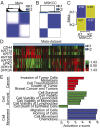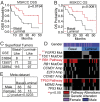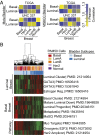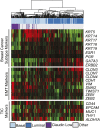Intrinsic subtypes of high-grade bladder cancer reflect the hallmarks of breast cancer biology
- PMID: 24520177
- PMCID: PMC3939870
- DOI: 10.1073/pnas.1318376111
Intrinsic subtypes of high-grade bladder cancer reflect the hallmarks of breast cancer biology
Abstract
We sought to define whether there are intrinsic molecular subtypes of high-grade bladder cancer. Consensus clustering performed on gene expression data from a meta-dataset of high-grade, muscle-invasive bladder tumors identified two intrinsic, molecular subsets of high-grade bladder cancer, termed "luminal" and "basal-like," which have characteristics of different stages of urothelial differentiation, reflect the luminal and basal-like molecular subtypes of breast cancer, and have clinically meaningful differences in outcome. A gene set predictor, bladder cancer analysis of subtypes by gene expression (BASE47) was defined by prediction analysis of microarrays (PAM) and accurately classifies the subtypes. Our data demonstrate that there are at least two molecularly and clinically distinct subtypes of high-grade bladder cancer and validate the BASE47 as a subtype predictor. Future studies exploring the predictive value of the BASE47 subtypes for standard of care bladder cancer therapies, as well as novel subtype-specific therapies, will be of interest.
Conflict of interest statement
Conflict of interest statement: J.S.D. and W.Y.K. have submitted a patent application for the BASE47 gene classifier.
Figures






Comment in
-
Genetics: what do breast and bladder cancer have in common?Nat Rev Clin Oncol. 2014 Apr;11(4):179. doi: 10.1038/nrclinonc.2014.33. Epub 2014 Feb 25. Nat Rev Clin Oncol. 2014. PMID: 24569446 No abstract available.
References
-
- Siegel R, Naishadham D, Jemal A. Cancer statistics, 2013. CA Cancer J Clin. 2013;63(1):11–30. - PubMed
-
- Goebell PJ, Knowles MA. Bladder cancer or bladder cancers? Genetically distinct malignant conditions of the urothelium. Urol Oncol. 2010;28(4):409–428. - PubMed
-
- Lindgren D, et al. Combined gene expression and genomic profiling define two intrinsic molecular subtypes of urothelial carcinoma and gene signatures for molecular grading and outcome. Cancer Res. 2010;70(9):3463–3472. - PubMed
Publication types
MeSH terms
Grants and funding
LinkOut - more resources
Full Text Sources
Other Literature Sources
Medical
Miscellaneous

